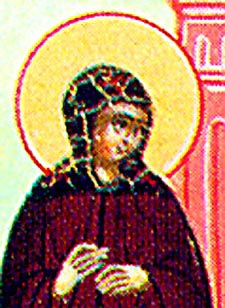Venerable Mary (who was called Marinus), and her father, Venerable Eugene, at Alexandria

The Venerable Mary (called Marinus) and her father Eugene, lived at the beginning of the VI century in Bithynia (Bithynίa - in the northwestern region of Asia Minor). When Maria's mother died, her father decided to enter a monastery, but Maria also wished to betroth herself to Christ . But Mary could not bear to be separated from her father, and so she donned male clothing. Together they entered a monastery, not far from Alexandria, where she was tonsured with the name Marinus.
"Brother" Marinus excelled in the virtues, and was distinguished by humility and obedience. When, a few years later, Saint Mary's father reposed, she intensified her ascetical labors and received from the Lord the gift of healing those possessed by unclean spirits.
One day the "monk" Marinus, along with some other brethren, was sent out on monastery business, and on the way they had to spend the night at an inn. The innkeeper's daughter, who had sinned with a soldier, and became pregnant, believed that Mary was a man, and burned with desire for the young "monk." The daughter humiliated herself when Mary repulsed her, and the wanton woman sought revenge. Therefore, she accused the "monk" of seducing her, naming "him" as the father of her child. Then she became possessed by a demon. The innkeeper complained to the Igoumen of the monastery, who expelled the "brother" who had sinned. Mary did not deny the false accusation, but went out to live near the monastery wall. When a boy was born to the sinful daughter, the innkeeper brought him to the "monk" Marinus, leaving his grandson with her and departed. The Saint took the infant and raised him as her own.
After three years, the brethren begged the Igoumen to accept the "monk" Marinus into the monastery again. Very reluctantly the Igoumen gave in to their requests, assigning to "Brother Marinus" the most onerous obediences, which the nun fulfilled with the utmost zeal, continuing to bring up her supposed son.
Three years later, the Saint peacefully departed to the Lord in her cell. The brethren who came saw the deceased "monk" and the boy weeping over "him." When they began to prepare her body for burial, her secret was revealed. The Igoumen tearfully begged forgiveness from the deceased, and the innkeeper followed his example. The Saint's body was reverently buried in the monastery. The daughter of the innkeeper came to the Saint's tomb and openly confessed her sin, after which she was immediately healed of her demonic possession. Later, the boy who was brought up by the nun, became a monk.
The Saint's relics were transferred to Constantinople, and from there they were taken to Venice in 1113.
